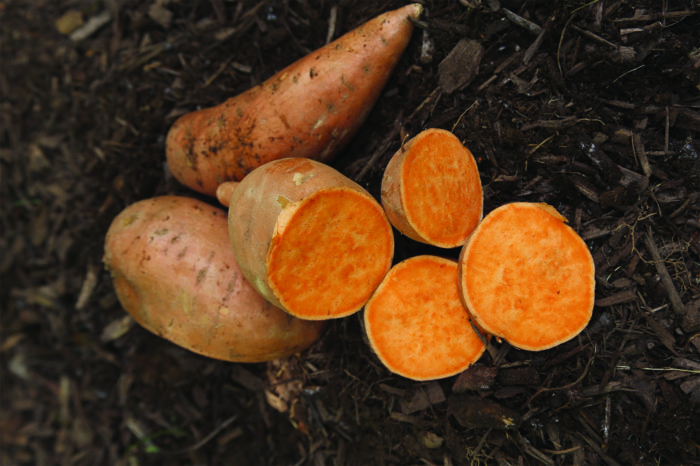‘Jersey Giant’ asparagus
Days to maturity: Harvest begins the second year after planting crowns
Asparagus is a perennial vegetable that can live up to 15 years. The variety ‘Jersey Giant’ is an all-male hybrid with pest resistance/tolerance, Fusarium resistance, rust resistance, and a very good eating quality. It also has the best yields of any variety I’ve grown. Plant certified, disease-free, one-year-old crowns in the spring three to four weeks before the last spring frost date.
Asparagus prefers a partial shade spot and a soil pH between 6.5 and 6.8 (it does poorly at pH levels below 6.0). Dig trenches 5 inches deep, and place the crowns with the roots spread out in the bottom. Fill in the trenches with soil as the spears grow, and be sure to mulch for moisture retention and weed suppression. In the second year, when the first spears emerge in spring, either harvest by bending the spears until they snap, or cut with a knife just below the soil surface. The harvest usually does not extend past June 15.
|
‘Georgia Jet’ sweet potato
Days to maturity: 80 to 90
A red-skinned variety that thrives in our region, ‘Georgia Jet’ has a moist orange flesh that is sweet and excellent for baking. The vines are deep green and have attractive purple-white flowers. Sweet potatoes are grown from slips (the green shoots from a mature sweet potato that are used for planting). Plant the slips in deeply cultivated soil after all danger of frost has passed in late spring to early summer. Nighttime temperatures need to remain above 60°F. Space the slips 10 to 18 inches apart in rows 36 inches apart. Start harvesting at around 80 days and the tubers will continue to grow until harvested. Cure the potatoes in a well-ventilated area for 8 to 10 days for the flesh of ‘Georgia Jet’ to develop a creamy, rich texture.
|
‘German Extra Hardy’ garlic
Days to maturity: 270
This variety features satin-white bulbs with a strong, spicy favor. Each ‘German Extra Hardy’ bulb is made up of about six to seven large, red-skinned inner cloves. The flavor is exceptional, and the plants have excellent hardiness, despite our harsh winters. Plant the garlic cloves by mid-October to ensure that roots are well established before the cold weather sets in. Garlic yields tend to increase as the size of the mother clove increases.
Therefore, choose the biggest cloves in the bulb for planting. Plant the individual cloves pointed end up 2 inches deep and 5 inches apart. Top-dress the planting area with compost, and then mulch to retain moisture and to prevent frost heaving. Pull back the mulch in spring to allow the soil to warm, then remulch to prevent weeds and conserve moisture. Stiff-neck garlic strains, like ‘German Extra Hardy’, produce flower stems (scapes) that should be removed.
|









Comments
My parents have their own small backyard garden, there are 4 people in our family and we have enough vagetables from it. I learn that garlic is good not only for its taste and vitamin qualities, but also for its remarkable ability to repel harmful insects and animals. This is a natural repellent with a strong odor that can save you hundreds of dollars on chemical products against flies, mosquitoes, beetles, raccoons and possums. In gardening magazine was written that we should planting garlic “wherever possible” to keep residents and other plants free from pests. On our backyard grows more than thousand garlic bushes, and not only on the ground, but also on the balcony, the roof, hanging on the fences of the beds. I even write my essay with detailed instructions for growing garlic.
Log in or create an account to post a comment.
Sign up Log in